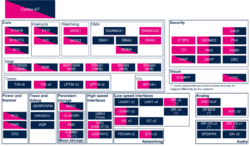- Last edited 9 months ago ago
DBGMCU internal peripheral
1 Article purpose[edit]
The purpose of this article is to:
- briefly introduce the DBGMCU peripheral and its main features
- indicate the level of security supported by this hardware block
- explain how each instance can be allocated to the runtime contexts and linked to the corresponding software components
- explain, when necessary, how to configure the DBGMCU peripheral.
2 Peripheral overview[edit]
The DBGMCU peripheral is used to configure internal peripherals behavior when one of the available cores enters in debug mode.
For instance, it allows to freeze a watchdog (IWDG) to avoid getting a watchdog reset when the Cortex®-A7 enters in debug mode (via a breakpoint or JTAG break).
2.1 Features[edit]
Refer to the STM32MP13 reference manuals or STM32MP15 reference manuals for the complete list of features, and to the software components, introduced below, to see which features are implemented.
2.2 Security support[edit]
The DBGMCU is a non secure peripheral.
3 Peripheral usage and associated software[edit]
3.1 Boot time[edit]
DBGMCU is used by the boot chain to get the device ID and revision, to adapt its behavior accordingly.
During a debug session, the DBGMCU can be accessed via the debug access port (DAP) to configure the expected behavior on break, typically to get IWDG2 frozen when the Cortex®-A7 enters in debug mode.
3.2 Runtime[edit]
3.2.1 Overview[edit]
There is no real runtime support for DBGMCU.
3.2.2 Software frameworks[edit]
3.2.2.1 On STM32MP13x lines  [edit]
[edit]
| Domain | Peripheral | Software components | Comment | |
|---|---|---|---|---|
| OP-TEE | Linux | |||
| Trace & Debug | DBGMCU | |||
3.2.2.2 On STM32MP15x lines  [edit]
[edit]
| Domain | Peripheral | Software components | Comment | ||
|---|---|---|---|---|---|
| OP-TEE | Linux | STM32Cube | |||
| Trace & Debug | DBGMCU | ||||
3.2.3 Peripheral configuration[edit]
The configuration is applied by the firmware running in the context to which the peripheral is assigned. The configuration can be done alone via the STM32CubeMX tool for all internal peripherals, and then manually completed (particularly for external peripherals), according to the information given in the corresponding software framework article.
3.2.4 Peripheral assignment[edit]
3.2.4.1 On STM32MP13x lines  [edit]
[edit]
Click on the right to expand the legend...
Check boxes illustrate the possible peripheral allocations supported by STM32 MPU Embedded Software:
- ☐ means that the peripheral can be assigned (☑) to the given runtime context.
- ⬚ means that the peripheral can be assigned to the given runtime context, but this configuration is not supported in STM32 MPU Embedded Software distribution.
- ✓ is used for system peripherals that cannot be unchecked because they are statically connected in the device.
Refer to How to assign an internal peripheral to an execution context for more information on how to assign peripherals manually or via STM32CubeMX.
The present chapter describes STMicroelectronics recommendations or choice of implementation. Additional possiblities might be described in STM32MP13 reference manuals.
| Domain | Peripheral | Runtime allocation | Comment | ||
|---|---|---|---|---|---|
| Instance | Cortex-A7 secure (OP-TEE) |
Cortex-A7 non-secure (Linux) | |||
| Trace & Debug | DBGMCU | DBGMCU | No assignment | ||
3.2.4.2 On STM32MP15x lines  [edit]
[edit]
Click on the right to expand the legend...
Check boxes illustrate the possible peripheral allocations supported by STM32 MPU Embedded Software:
- ☐ means that the peripheral can be assigned (☑) to the given runtime context.
- ⬚ means that the peripheral can be assigned to the given runtime context, but this configuration is not supported in STM32 MPU Embedded Software distribution.
- ✓ is used for system peripherals that cannot be unchecked because they are statically connected in the device.
Refer to How to assign an internal peripheral to an execution context for more information on how to assign peripherals manually or via STM32CubeMX.
The present chapter describes STMicroelectronics recommendations or choice of implementation. Additional possiblities might be described in STM32MP15 reference manuals.
| Domain | Peripheral | Runtime allocation | Comment | |||
|---|---|---|---|---|---|---|
| Instance | Cortex-A7 secure (OP-TEE) |
Cortex-A7 non-secure (Linux) |
Cortex-M4 (STM32Cube) | |||
| Trace & Debug | DBGMCU | DBGMCU | No assignment | |||



